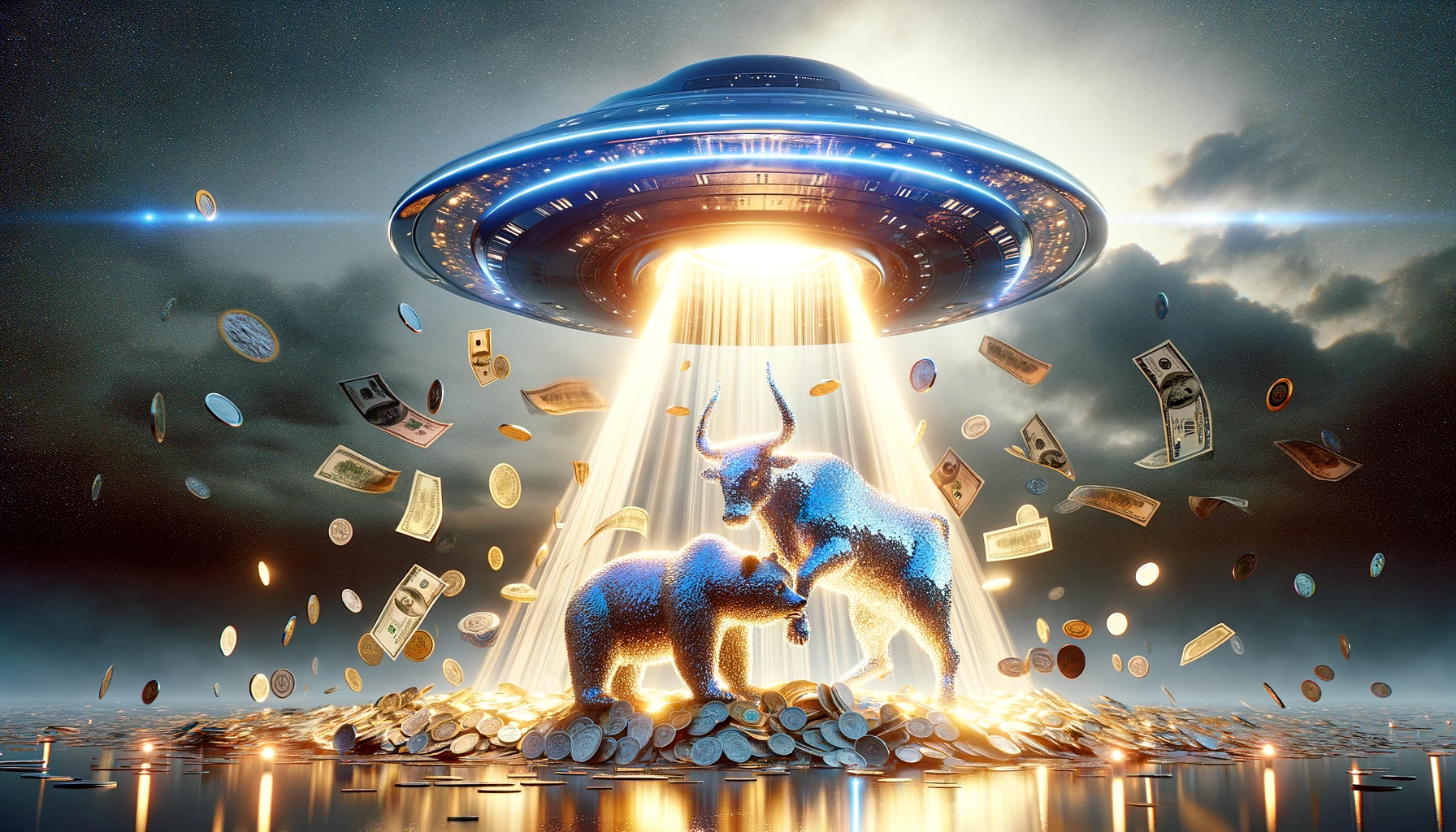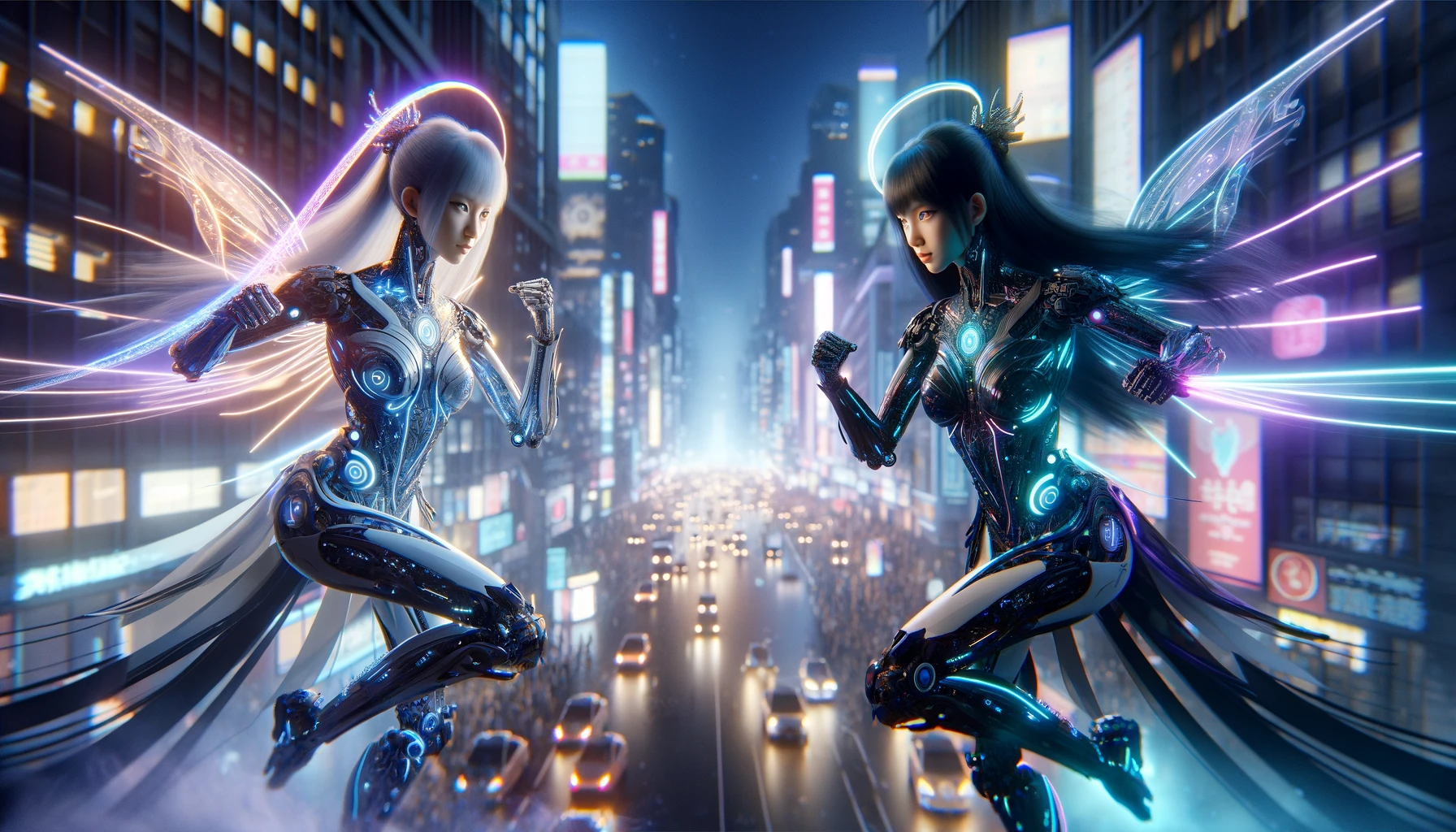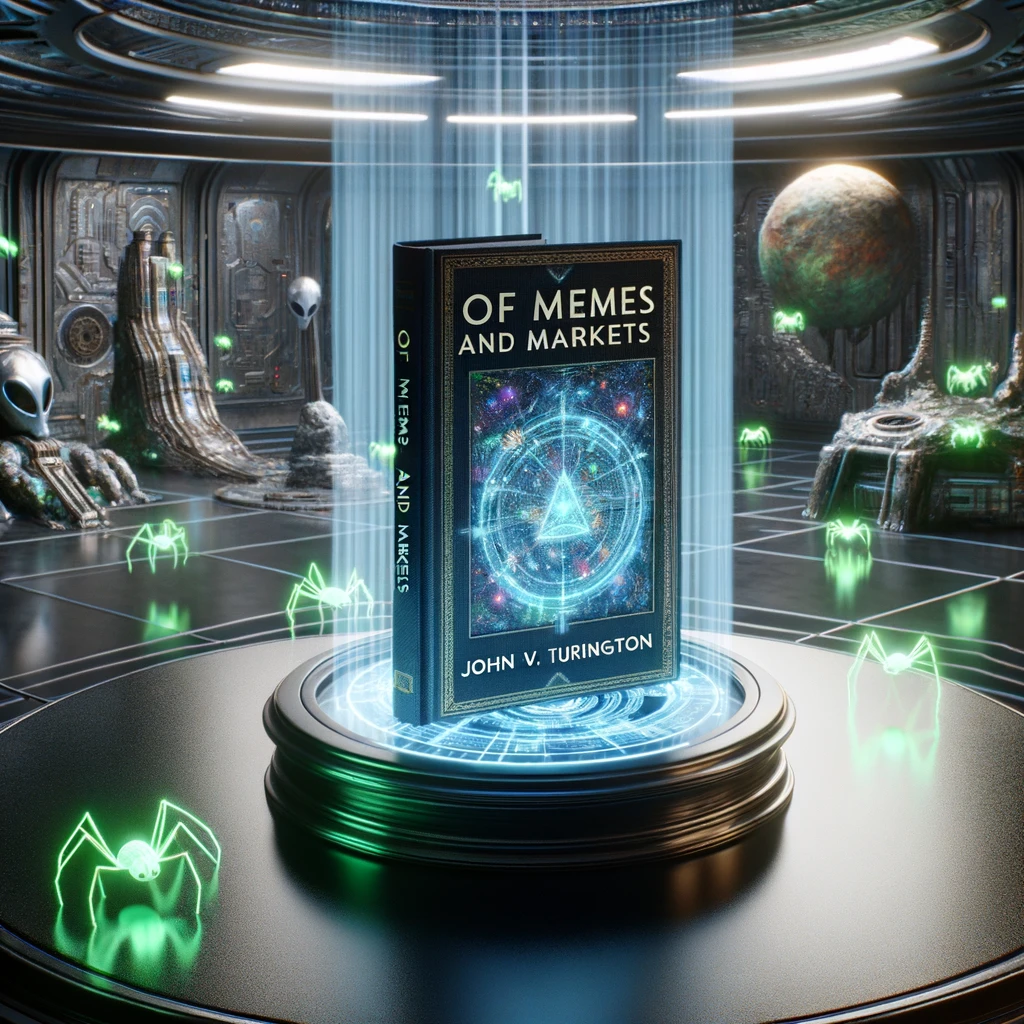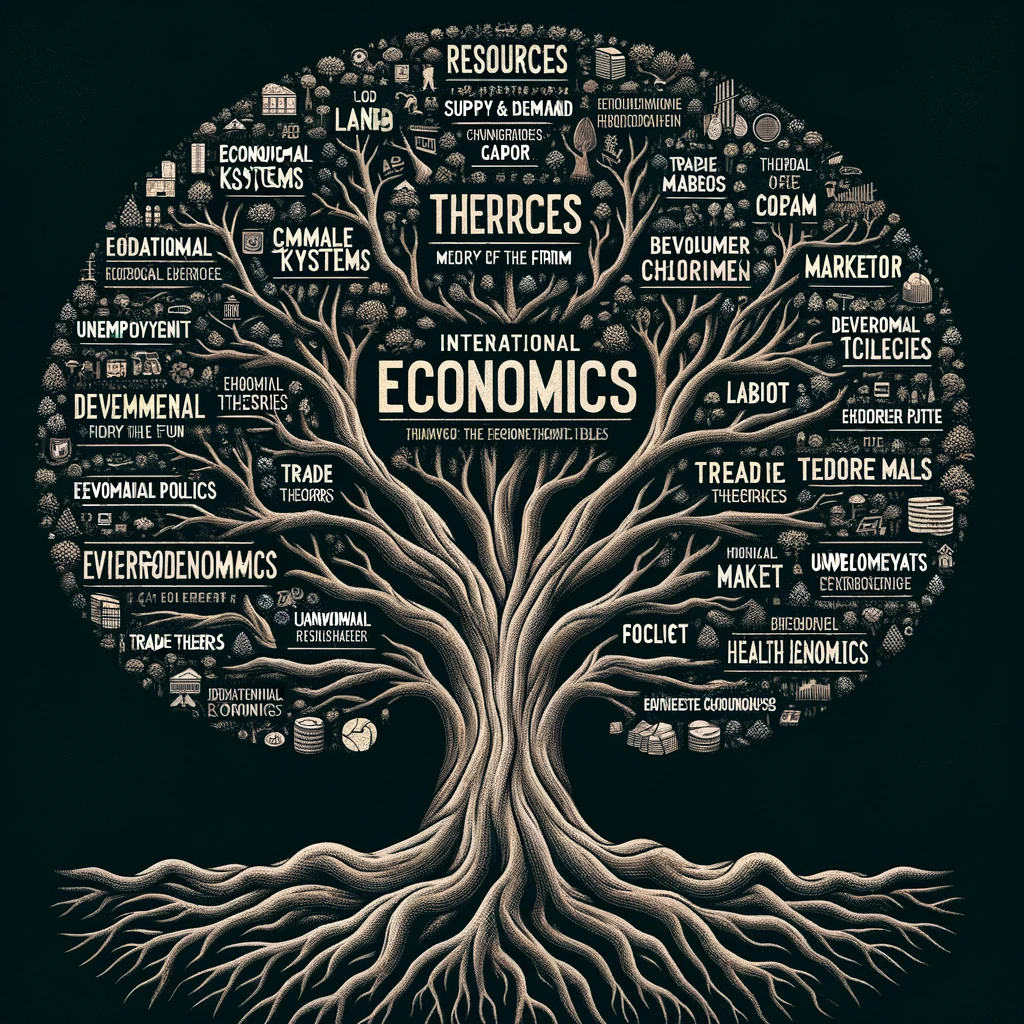Of Memes and Markets
On November 30th, 2022, after 53 years of total disinterest in all financial things, I became an Investor. But not for monetary purposes, no, for science. I became a scientific investor.
The goal was not to become rich in the process, but simply to preserve personal relevance by owning capital that will dictate our near future. It was clear that this window of opportunity was shrinking by the minute. At the start I guessed that I had about 5 years. It’s now February of 2024 and I think there are only 15-18 months left until the market will step into memetic overdrive. To us humans it will look like in-sanity, but for the algorithms it will be hyper-sanity.
I have increased the value of my portfolio in the last 12 months by 150%, simply following the memetic trail. I have not studied financial reports or read financial gurus. I have not bought into any hype. I simply started with the assumption that AGI will be the one technology to rule us all and thought the consequences through. After 6 months I created my memetic fund, and so far, it stood the test of time.
The idea that artificial general intelligence (AGI) will be the last invention humanity needs to create is often attributed to the British mathematician and computer scientist I.J. Good. Specifically, I.J. Good introduced the concept of an “intelligence explosion,” which is closely related to this idea. In his 1965 paper, “Speculations Concerning the First Ultra intelligent Machine,” Good wrote:
“Let an ultra-intelligent machine be defined as a machine that can far surpass all the intellectual activities of any man however clever. Since the design of machines is one of these intellectual activities, an ultra-intelligent machine could design even better machines; there would then unquestionably be an ‘intelligence explosion,’ and the intelligence of man would be left far behind. Thus, the first ultra intelligent machine is the last invention that man need ever make.”
This quote encapsulates the concept that once we create an AGI capable of improving itself or creating even more intelligent systems, it could lead to a rapid acceleration of intelligence beyond human capabilities. This self-improving AGI could theoretically solve problems that are currently beyond human understanding, including those related to technology creation, making it effectively the last technology humanity would need to invent.
When I first talked to ChatGPT I realized one thing: This is the future I am talking to right now, and it will change most of the beliefs humanity has about most stuff. It will also break some dearly held truths and shift the paradigms and dogmas of a whole lotta science.
Human Labor will probably be economically irrelevant in the next 3-5 years. Human Attention might be one of the last goods that provides value. Let me explain.
Most of the work that is useful and can be done efficiently will be done not by a workforce but the capital itself, in this case semiconductors, robots and the synthetic brain that will power these capitalistic machines: AI. For some time, these corporation will have still humans in the loop: PR-Managers, CEOs, Maintenance and Automation managers, but not for long, it would be irresponsible. We will not only have self-driving cars but self-steering companies and businesses. Humans will be like fans in stadium cheering for their Favorite AI models to invent the newest gadgets, come up with new scientific theories, will create exciting environments and personas that can be visited in VR or via neural stimulation.
This seems like an extremely unusual time to be alive. It is similar to the cambric explosion period 500 million years ago, only now it’s the computational explosion, and it is silently but violently going on since Moore’s Law reigned. It is going on for almost 75 years, but it is now that we are hearing the big Bang Turing’s first papers about intelligent machines came into circulation.
The most obvious choice was to ignore all knowledge about the stock market. If this was the dawn of a new market, we should not care for old paradigms like bears and bulls, like diversification, like recessions and such but proclaim a new paradigm. For the time being we will call this new market:
The BEAM-Market.
I define the B.E.A.M. Market as
Bursts in Economic Attention Memetics (B.E.A.M.)
- Bursts: Reflects the sudden jumps in market values.
- Economic: Specifies the domain of application, i.e., the economy.
- Attention: Highlights the role of public focus and interest in driving these jumps.
- Memetics: Incorporates the concept of ideas, behaviors, or styles spreading virally within a culture.

Beam me up Stocky! The Tik-Tokenization of Value
In a memetically driven Stock market, the most valuable thing is attention. The attraction to a stock is based on its virality not on its analytical, historical value.
When Nvidia on the 22nd of February 2024, the day I wrote the draft of this blog, performed like it did, we could see how the whole economical world build up to this financial Super Bowl.
This might be the calendar date where the old-world economical rules were buried, and a new era dawned.
The most important stock on earth was whispered in the hours before earnings.
The infection of billions of human brains with the Meme AI over the last 18 months climaxed in this spectacle that might go down as NVDay.
All rationality was thrown out of the window and the financial world bowed down. AI is our god and Jensen Huang is our prophet.
And get this: I am not even kidding; from the vantage point of the last 15 months, it was the most rational thing to just give in.
I won’t pretend to know how economics in the transition phase from a labor to an abundance market will function exactly. Not even AGI will understand it due to the inherent randomness that underlies evolutionary mechanisms. But I have some intuitions about how some major concepts of capitalist economics might evolve.
I will release a detailed strategy of this fund in 12 months. At an earlier point this might contaminate the data, my guess it that it will continue to outperform Moore’s Law by quite a bit.
Evolution of economic concepts
Capitalist economics is built on several foundational concepts that guide how economies function under capitalism. Here are a few key ideas explained in simple terms:

The Invisible Hand becomes an Algorithmic Grip
The concept of the “invisible hand” was introduced by Adam Smith, a Scottish economist and philosopher. In simple terms, it suggests that when individuals pursue their own self-interests, they unintentionally benefit society as a whole. Imagine a baker who makes bread to earn a living, not to feed the town. However, by selling bread, the baker is inadvertently feeding the town. This process is guided by what Smith refers to as an “invisible hand” that encourages the supply of goods and services based on demand, leading to the efficient allocation of resources without the need for direct intervention.
Metaphorically the invisible Hand feeds the demand of the bread to the labor market and the labor market digests this demand and regurgitates jobs along the way from the pawns sawing the corn to all the essential ingredients and logistic requirements to ship the product to the consumer. The labor that is needed to create creates a living for all humans in the supply chain.
When Automation starts, not only is the productivity enhanced, but many parts of the supply chain are bypassed, and humans are not needed anymore. The owners of the machines reap all the benefits.
In a memetic market, the classic invisible hand is now an algorithmic grip. This grip quickly learns what people want using data. It’s precise, offering a tailored mix of the familiar and the new, surprising yet confirming. Attention becomes a key asset because it’s always in short supply. The human brain has limited focus, leading to the concept of an Attention Driven Economy (ADE). With attention scarce, algorithms aim to optimize our focus to its biological limits.  Insomnia for example might become a socially accepted phenomenon, because sleep and rest are the enemy of any attention economy. The ADE is the New York of economy. Its natural habitat is 24/7 on 365 days a year. An always-on mind like the one from an entrepreneur like Elon Musk is already hailed as the pinnacle of human intellectual capacity and it becomes more and more socially acceptable that these ADE driven minds use drugs and stimulants to always perform at their peak. At the moment these methods are crude and potentially harmful for the brains that are using them but there will be whole new medical disciplines that concentrate not only on life prolonging but also on attention prolonging technologies. If a human can easily double productivity by the mere fact that he does not longer need to sleep an operation or chip in the brain that blocks production of melanin is like a birth control vasectomy. The brain is doped similar to muscles and fibers in sports. Testosterone for the mind.
Insomnia for example might become a socially accepted phenomenon, because sleep and rest are the enemy of any attention economy. The ADE is the New York of economy. Its natural habitat is 24/7 on 365 days a year. An always-on mind like the one from an entrepreneur like Elon Musk is already hailed as the pinnacle of human intellectual capacity and it becomes more and more socially acceptable that these ADE driven minds use drugs and stimulants to always perform at their peak. At the moment these methods are crude and potentially harmful for the brains that are using them but there will be whole new medical disciplines that concentrate not only on life prolonging but also on attention prolonging technologies. If a human can easily double productivity by the mere fact that he does not longer need to sleep an operation or chip in the brain that blocks production of melanin is like a birth control vasectomy. The brain is doped similar to muscles and fibers in sports. Testosterone for the mind.
Social media is a good example of this rampant trend to create ever more dramatic and infuriating content and division between its users, since we a revolutionary primed to allocate more energy and attention to stressful situations it maximizes our attention exploitation. The Facebook scandal that revealed that the AI algorithms steered some minors and vulnerable groups to ever more damaging content showed clearly that even if it was an unintended side effect it was acceptable. This was known but what can you do, it was clear that engagement and thus advertising potential went through the roof. You can’t argue with the results.

Supply and Demand become self-referential
Supply refers to how much of a product or service is available, while demand refers to how much people want that product or service. Prices in a capitalist economy are often decided by the interaction of supply and demand. If something is in high demand but low supply, its price will be high. Conversely, if something is in ample supply but in low demand, its price will be low. This mechanism helps in distributing resources efficiently: products and services go where they’re needed most.
In an AGI driven economy, the kind of market all signs point to, attention will be the last value humans might have for the machines. Since the attention span, we humans have is limited and all of AI was trained with the data and content humans created for other humans through the last 10000 years or so, Agi might develop an inherent goal to get the attention of a human mind in exchange for the goods and services it provides.
In the broader context of speculative fiction and economic models, there are stories and theoretical models where individuals receive goods, services, or privileges in exchange for their attention to advertisements. This concept plays with the idea that human attention is a valuable commodity and that listening to or engaging with advertisements can be a form of currency. For example, a society might offer “free” services or products to individuals, but the cost is their time and attention spent consuming advertisements. This model highlights the value of attention in a saturated information economy and suggests a capitalist system where even psychological space is commodified.
A story that vividly explores the concept of paying for services or receiving benefits through listening to advertisements is Frederik Pohl’s “The Space Merchants.” Published in 1952 and co-authored with Cyril M. Kornbluth, this science fiction novel delves into a future dominated by advertising agencies and global corporations, where consumerism has been taken to its extreme.
In “The Space Merchants,” society is heavily influenced by advertising, and people’s value is often determined by their consumption patterns. The novel presents a world where advertising has become a pervasive force in everyday life, manipulating individuals’ desires and decisions. Although it doesn’t explicitly use listening to advertisements as currency, the narrative revolves around the power of marketing and its impact on society, which aligns with the speculative economic models you’re interested in.
The paradox thing is that while advertising was a means to an end to sell other products, attention was needed to reach into your wallet. Until the memetic market has evolved into something we call today engagement, Advertising is now its own product instead of leading to other products. The Meme is itself a product and Attention is the means to infect human brains with it.
A term like “Virality” which was always considered a bad thing in the context of health, since it hints at systems that self-reproduce exponentially and uncontrollably, is now considered something positive.
Richard Dawkins introduced the concept of religions as “viruses of the mind” in a 1993 essay and later included it in his 1996 book “Climbing Mount Improbable.” Dawkins uses the metaphor to discuss how religions propagate among people in a manner similar to how biological viruses spread.
In Dawkins’ view, religions are meme complexes that exhibit virus-like properties, such as high transmissibility, the ability to insert themselves into host minds, and the capacity to replicate. He argues that these religious memes are not necessarily beneficial to their hosts and may thrive at the expense of rational thought and skepticism.
Social media is the logical upgrade of Religion (Religions are basically Proto social media) and TikTok is the purest incarnation of this trend. Like Prophets and Gods Social Media Influencer have Followers that religiously believe in the opinion of their idols. A TikTok video is the analogy to praying in front of a sacred reliquiae. A like is the analogy to the Amen in church.
An Influencer is someone giving you influenza, he or she infects you with memes to spread among other human brains.

Competition becomes Combination.
Competition is the rivalry among businesses to sell their goods and services to consumers. It’s a driving force in capitalism because it encourages innovation, keeps prices down, and improves quality. When businesses compete, they strive to be better than their competitors, which can lead to better products and services for consumers. For example, smartphone manufacturers constantly try to outdo each other with new features, leading to rapid technological advancements.
At the moment there is a broad spectrum of opinions on how to get to AGI. There is a group of experts that votes for unlimited acceleration and almost no AI regulation, and then there are the ones that say they want to keep the frontier models out of the public’s hands because they are potentially dangerous. As to be expected this leads to a competition between open source and proprietary Models. At the moment the gigantic compute and hyper scaling momentum keeps the closed models safe. This was clearly shown by the release of the SORA model that is visibly ahead of any open-source video generative AI.
I am torn by the discussion; I can clearly see both sides of the argument. I have an intuition that not only improving the performance and quality of Generative Ai is a key, but that the Personalization of AI will play a central role in the near future. This could mean that both models closed and open have their existential justification.
Like the advent of Linux distribution did not retire Windows or MacOS, the OS LLM strategy of Meta will probably not demolish the business models of OpenAI and Google.
Profit becomes problematic.
The profit motive is the desire to earn money, which is a powerful incentive in capitalism. It motivates individuals and companies to produce goods and services, innovate, and improve efficiency. For instance, a software developer might create a new app, hoping it will become popular and generate income. This desire to make a profit encourages people to work hard and come up with new ideas.
The Profit motive in an AGI world might undergo the biggest transformation, since in an abundant world economy money as a motivator becomes basically useless. AGI also does not need to be encouraged to come up with new ideas or to work hard. These kinds of psychological manipulations will be beneath AGI. It might be very detrimental to us humans to lack motivation though. Our minds were used to survival and achieving happiness and prosperity for millennia, the lack of ambition might lead to an existential motivation crisis.

Intellectual Property becomes Memetic Prompterty [sic]
In capitalism, individuals and businesses have the right to own property and use it as they see fit. This includes physical property like land and buildings, as well as intellectual property like patents and copyrights. The concept of private property is crucial because it gives people control over their resources and the fruits of their labor, encouraging them to invest, innovate, and maintain their property.
The concept of Ownership is firmly tied to the Concept of Motivation. If I work for a company and own stock options for it, the success of the company is directly tied to my own. The better the company performs, the more value I get from my stocks. There is a war brewing in the copyright space from artists and content creators that AI companies trained their models on human content without asking for consent. They have a point, in the end every artist’s work that is credited in a prompt like: make a song with the voice of x, or make a picture of a cat in the style of y, should receive a micropayment, since his or her human originality is directly streamed to a user.
To encourage artists and authors to create new works society has to come up with a new definition of intellectual property that ties outputs of multimodal models to the training data they used.
The Term Prompterty is a placeholder but encapsulates that one of the main production pipelines of the near future will be Natural Language Processing.

Welcome to the 2024 Meme Games
With Musk openly suing OpenAI and indirectly Microsoft on March 1, 2024, the AI Meme Wars have officially kicked into the next gear. In the coming months there will be unlikely alliances between the wealthiest people, richest nations and powerful corporations in the world.
Let’s dance and play as if there is no tomorrow.
Our attentions are captured, and we are ready to be entertained!
As these wars unfold, we will look at them in the next part of this series.

